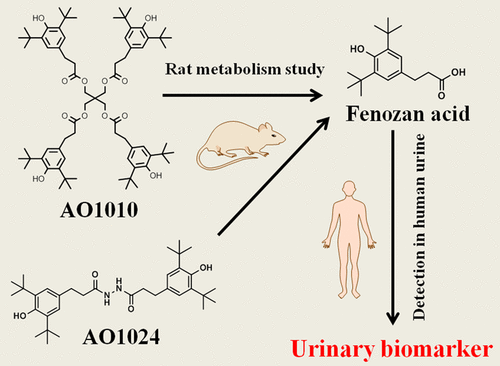当前位置:
X-MOL 学术
›
Environ. Sci. Technol.
›
论文详情
Our official English website, www.x-mol.net, welcomes your
feedback! (Note: you will need to create a separate account there.)
Rat Metabolism Study Suggests 3-(3,5-Di-tert-butyl-4-hydroxyphenyl)propionic Acid as a Potential Urinary Biomarker of Human Exposure to Representative 3-(3,5-Di-tert-butyl-4-hydroxyphenyl)propionate Antioxidants
Environmental Science & Technology ( IF 10.8 ) Pub Date : 2021-10-07 , DOI: 10.1021/acs.est.1c03493 Runzeng Liu 1 , Scott A Mabury 1
Environmental Science & Technology ( IF 10.8 ) Pub Date : 2021-10-07 , DOI: 10.1021/acs.est.1c03493 Runzeng Liu 1 , Scott A Mabury 1
Affiliation

|
3-(3,5-Di-tert-butyl-4-hydroxyphenyl)propionate antioxidants, a family of synthetic phenolic antioxidants (SPAs) widely used in polymers, have recently been identified in indoor and outdoor environments. However, limited information is available concerning human exposure to these novel contaminants. In the present study, seven 3-(3,5-di-tert-butyl-4-hydroxyphenyl)propionate antioxidants were analyzed in human urine samples of donors from the United States. None of the target SPAs were initially detected in the urine samples either before or after hydrolysis by β-glucuronidase, prompting us to probe the major metabolites of these SPAs. We conducted rat metabolism studies with two representative congeners, tetrakis(3-(3,5-di-tert-butyl-4-hydroxyphenyl)propionate) (AO1010) and N,N′-bis[3-(3,5-di-tert-butyl-4-hydroxyphenyl)propionyl]hydrazine (AO1024). Neither AO1010 nor AO1024 was detected in rat urine, while 3-(3,5-di-tert-butyl-4-hydroxyphenyl)propionic acid (fenozan acid) was identified as a urinary biomarker for these 3-(3,5-di-tert-butyl-4-hydroxyphenyl)propionate antioxidants. Surprisingly, fenozan acid was detected in 88% of the human urine samples before hydrolysis (geometric mean: 0.69 ng/mL) and 98% of the samples after hydrolysis (geometric mean: 10.2 ng/mL), indicating prevalent human exposure to 3-(3,5-di-tert-butyl-4-hydroxyphenyl)propionate antioxidants. To our knowledge, this is the first study reporting the occurrence of fenozan acid in urine, where it can act as a potential biomarker of human exposure to 3-(3,5-di-tert-butyl-4-hydroxyphenyl)propionate antioxidants.
中文翻译:

大鼠代谢研究表明 3-(3,5-二叔丁基-4-羟基苯基)丙酸作为人类暴露于代表性 3-(3,5-二叔丁基-4-羟基苯基) 的潜在尿液生物标志物丙酸抗氧化剂
3-(3,5-二叔丁基-4-羟基苯基)丙酸酯抗氧化剂是一类广泛用于聚合物的合成酚类抗氧化剂 (SPA),最近已在室内和室外环境中得到鉴定。然而,关于人类暴露于这些新型污染物的信息有限。在本研究中,对来自美国的捐献者的人体尿液样本中的7 种 3-(3,5-二叔丁基-4-羟基苯基)丙酸酯抗氧化剂进行了分析。在 β-葡萄糖醛酸酶水解之前或之后,尿液样本中最初均未检测到目标 SPA,这促使我们探索这些 SPA 的主要代谢物。我们进行了大鼠代谢研究有两个代表性的同系物,四(3-(3,5-二叔-丁基-4-羟基苯基)丙酸酯)(AO1010)和N,N'-双[3-(3,5-二-叔丁基-4-羟基苯基)丙酰基]肼(AO1024)。在大鼠尿液中均未检测到 AO1010 和 AO1024,而 3-(3,5-二叔丁基-4-羟基苯基)丙酸 (fenozan acid) 被鉴定为这些 3-(3,5-di -叔丁基-4-羟基苯基)丙酸酯抗氧化剂。令人惊讶的是,在水解前 88% 的人类尿液样本(几何平均值:0.69 ng/mL)和水解后 98% 的样本(几何平均值:10.2 ng/mL)中检测到芬诺赞酸,表明人类普遍暴露于 3- (3,5-二叔-丁基-4-羟基苯基)丙酸酯抗氧化剂。据我们所知,这是第一项报告尿液中芬诺赞酸的研究,它可以作为人类暴露于 3-(3,5-二叔丁基-4-羟基苯基)丙酸酯抗氧化剂的潜在生物标志物。
更新日期:2021-10-19
中文翻译:

大鼠代谢研究表明 3-(3,5-二叔丁基-4-羟基苯基)丙酸作为人类暴露于代表性 3-(3,5-二叔丁基-4-羟基苯基) 的潜在尿液生物标志物丙酸抗氧化剂
3-(3,5-二叔丁基-4-羟基苯基)丙酸酯抗氧化剂是一类广泛用于聚合物的合成酚类抗氧化剂 (SPA),最近已在室内和室外环境中得到鉴定。然而,关于人类暴露于这些新型污染物的信息有限。在本研究中,对来自美国的捐献者的人体尿液样本中的7 种 3-(3,5-二叔丁基-4-羟基苯基)丙酸酯抗氧化剂进行了分析。在 β-葡萄糖醛酸酶水解之前或之后,尿液样本中最初均未检测到目标 SPA,这促使我们探索这些 SPA 的主要代谢物。我们进行了大鼠代谢研究有两个代表性的同系物,四(3-(3,5-二叔-丁基-4-羟基苯基)丙酸酯)(AO1010)和N,N'-双[3-(3,5-二-叔丁基-4-羟基苯基)丙酰基]肼(AO1024)。在大鼠尿液中均未检测到 AO1010 和 AO1024,而 3-(3,5-二叔丁基-4-羟基苯基)丙酸 (fenozan acid) 被鉴定为这些 3-(3,5-di -叔丁基-4-羟基苯基)丙酸酯抗氧化剂。令人惊讶的是,在水解前 88% 的人类尿液样本(几何平均值:0.69 ng/mL)和水解后 98% 的样本(几何平均值:10.2 ng/mL)中检测到芬诺赞酸,表明人类普遍暴露于 3- (3,5-二叔-丁基-4-羟基苯基)丙酸酯抗氧化剂。据我们所知,这是第一项报告尿液中芬诺赞酸的研究,它可以作为人类暴露于 3-(3,5-二叔丁基-4-羟基苯基)丙酸酯抗氧化剂的潜在生物标志物。





















































 京公网安备 11010802027423号
京公网安备 11010802027423号